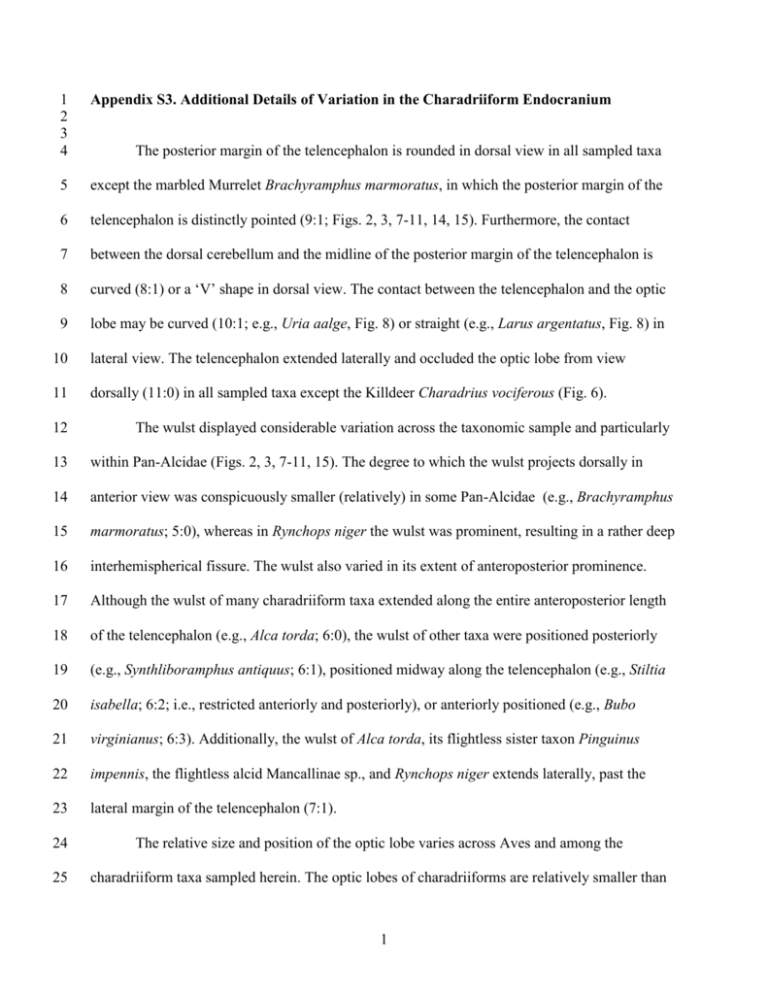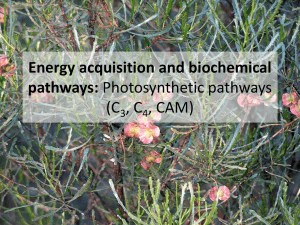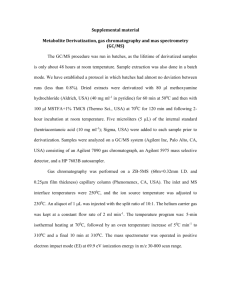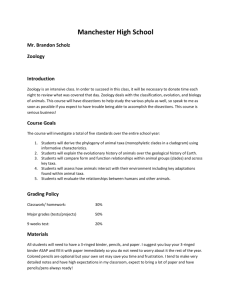Appendix S3. Additional Details of Variation in the Charadriiform
advertisement

1 2 3 4 Appendix S3. Additional Details of Variation in the Charadriiform Endocranium 5 except the marbled Murrelet Brachyramphus marmoratus, in which the posterior margin of the 6 telencephalon is distinctly pointed (9:1; Figs. 2, 3, 7-11, 14, 15). Furthermore, the contact 7 between the dorsal cerebellum and the midline of the posterior margin of the telencephalon is 8 curved (8:1) or a ‘V’ shape in dorsal view. The contact between the telencephalon and the optic 9 lobe may be curved (10:1; e.g., Uria aalge, Fig. 8) or straight (e.g., Larus argentatus, Fig. 8) in The posterior margin of the telencephalon is rounded in dorsal view in all sampled taxa 10 lateral view. The telencephalon extended laterally and occluded the optic lobe from view 11 dorsally (11:0) in all sampled taxa except the Killdeer Charadrius vociferous (Fig. 6). 12 The wulst displayed considerable variation across the taxonomic sample and particularly 13 within Pan-Alcidae (Figs. 2, 3, 7-11, 15). The degree to which the wulst projects dorsally in 14 anterior view was conspicuously smaller (relatively) in some Pan-Alcidae (e.g., Brachyramphus 15 marmoratus; 5:0), whereas in Rynchops niger the wulst was prominent, resulting in a rather deep 16 interhemispherical fissure. The wulst also varied in its extent of anteroposterior prominence. 17 Although the wulst of many charadriiform taxa extended along the entire anteroposterior length 18 of the telencephalon (e.g., Alca torda; 6:0), the wulst of other taxa were positioned posteriorly 19 (e.g., Synthliboramphus antiquus; 6:1), positioned midway along the telencephalon (e.g., Stiltia 20 isabella; 6:2; i.e., restricted anteriorly and posteriorly), or anteriorly positioned (e.g., Bubo 21 virginianus; 6:3). Additionally, the wulst of Alca torda, its flightless sister taxon Pinguinus 22 impennis, the flightless alcid Mancallinae sp., and Rynchops niger extends laterally, past the 23 lateral margin of the telencephalon (7:1). 24 The relative size and position of the optic lobe varies across Aves and among the 25 charadriiform taxa sampled herein. The optic lobes of charadriiforms are relatively smaller than 1 1 those of the tinamou [13], but are not completely covered in lateral view by the telencephalon as 2 in Apteryx (kiwis) and Dinornis (moas; [18]). The width of the apparent contact between the 3 optic lobe and the cerebellum is related to the occlusion of the optic lobe by the posterior 4 telencephalon. In lateral view the optic lobe appears to posteriorly taper to a point in most 5 charadriiform taxa (e.g., Rissa tridactyla), whereas in a few taxa (e.g., Stiltia isabella; Fig. 8) the 6 contact between the posterior margin of the optic lobe and the cerebellum is broader. Flightless 7 taxa Pinguinus impennis and Mancallinae sp. have relatively smaller optic lobes than other pan- 8 alcids (12:0; Figs. 3, 9). 9 Pronounced variation was documented in the cerebellum of sampled charadriiform taxa; 10 cerebellar morphology is known to be highly variable in Aves [34], [45], [46]. The occipital 11 sinus is conspicuous on the dorsal cerebellum in some taxa (e.g., Rynchops niger; 13:1), whereas 12 this feature was not discernable in other species (e.g., Alca torda). Likewise, cerebellar fissures 13 were evident along the dorsal and posterior cerebella (17:0) of the sampled outgroup taxa to Pan- 14 Alcidae but were not evident in pan-alcids. There is substantial variation in the relative 15 maximum width of the cerebellum (in dorsal view), as compared to the telencephalon (Figs. 2, 3, 16 7-11, 14, 15). Additionally, the dorsal portion of the cerebellum varies in the extent that it 17 contacts the posterior margin of the telencephalon. The cerebellum of Stiltia isabella, Charadrius 18 vociferus, and Fratercula corniculata are dorsally restricted in comparison to those of other 19 sampled taxa (e.g., Aethia cristatella), in which more than half of the posterior telencephalon is 20 in contact with the cerebellum (14:0). All sampled charadriiform taxa displayed a distinct sulcus 21 for passage of the semicircular vein (Figs. 2, 3, 7-11, 15). The length of the cerebellum relative 22 to the telencephalon varied; in the majority of charadriiform taxa (e.g., Alle alle) the length of the 23 cerebellum was less than 50% that of the telencephalon (15:0). 2 1 The floccular lobes of the cerebellum varied in their length, overall shape, and possession 2 of a fenestra. Their lobes varied from rather small, irregularly triangular lobes with tapered edges 3 (20:0), to relatively larger, more robust, approximately rectangular lobes with thickened dorsal 4 and ventral margins (20:1). The floccular lobes of the two terrestrial charadriiform taxa sampled 5 (Stiltia isabella, Charadrius vociferus) were noticeably smaller than those of other 6 charadriiforms (mediolateral length less than dorsoventral height; 18:0; Fig. 14). Other terrestrial 7 palaeognath taxa such as the tinamous, kiwis, and moas also lack well-developed floccular lobes 8 [18]. Relatively long floccular lobes were evident in many pan-alcids (e.g., Mancallinae sp.) and 9 Halcyornis toliapicus (mediolateral length more than twice dorsoventral height; 18:2). Large 10 floccular lobes are also seen in some galloanserines that inhabit both terrestrial and aquatic 11 niches (e.g., Chauna chauvaria, Anas platyrynchos, Gallus gallus, Phasianus versicolor; [18], 12 [40]). Curiously, this feature is highly variable in penguins, with the floccular lobes of 13 Paraptenodytes antarcticus and Spheniscus humboldti substantially larger than those of 14 Aptenodytes patagonicus and Pygoscelis antarctica [17]. The flocculus of only three sampled 15 species, Alca torda, Sterna anaethetus, and Stercorarius longicaudus, was fenestrated (19:1), the 16 significance of which is unknown because this feature is reported here for the first time and its 17 distribution within Aves is uncertain. 18 The olfactory bulb was variably bifurcated (3:0) or a single tract within Pan-Alcidae and 19 its sister taxon, Stercorariidae (Figs. 2, 3, 7-11, 15). The olfactory bulbs of Rissa tridactyla and 20 Stiltia isabella are relatively smaller than those of other sampled taxa (1:0; see Appendix 1 for 21 quantification of relative size terms used throughout). The relative size range of charadriiform 22 olfactory bulbs are comparable to that represented by Chauna chavaria and Anas platyrhychos 23 within Anseriformes (relatively large to relatively small, respectively). The hypertrophied 3 1 condition in Apteryx mantelli or Struthio camelus [13], [18] was not observed in this sample. 2 Because the relative size of olfactory bulbs in birds is correlated more strongly with olfactory 3 capabilities than with relative endocranial volume or body size [14], the range of olfactory bulb 4 relative size in Charadriiformes suggests that there is variation in the degree to which different 5 species in this sample depend on olfactory sense. 6 Additional morphological variation documented in sampled taxa included differences in 7 the rhombencephalon, pituitary gland, and the carotid arteries. An anteroposteriorly oriented 8 sulcus was evident along the ventral surface of the rhombencephalon many taxa (21:0; sulcus 9 absent or indistinct in Pan-Alcidae, Stercorarius, and Halcyornis toliapicus). The paired carotid 10 rami alternatively entered the pituitary gland (i.e., hypophysis) separately (23:1), or else they 11 anastomosed prior to entry into the pituitary gland (23:0). Additional structures such as the 12 paired glosopharyngeal and vagus nerves (IX-XI) and trigeminal nerve (V2,3) were discernable in 13 the digital endocranial endocasts (Figs. 2, 3, 7-11, 14, 15). However, the relative size, position, 14 and conformation of cranial nerves are relatively invariant among the sampled taxa. The relative 15 size and position of the foramen magnum was also largely conserved among sampled taxa. 16 Whereas the ventral margin of the optic tract and the dorsal margin of the pituitary gland of pan- 17 alcids are in contact (22:1), these structures are separated in other charadriiforms. 18 In addition to morphological variation of individual brain regions, variation in the relative 19 positions of brain regions was also identified. The relative positions of the telencephalon, optic 20 lobe, and endosseous labyrinth conform to two distinct groups. The brain regions and endosseous 21 labyrinth of several terrestrial charadriiform species Charadrius vociferus, Stiltia isabella and 22 Rostratula benghalensis, and those in the wing-propelled diving alcids Fratercula cirrhata and 23 Fratercula corniculata, are more vertically oriented or “stacked” than those of other sampled 4 1 taxa (24:0; Figs. 2, 3, 7-11, 14, 15); the telencephalon of species these taxa is less anteriorly 2 expanded, and the endosseous labyrinths are positioned more anteriorly (i.e., ventral to the optic 3 lobe). By contrast, the telencephalon is positioned more anteriorly and endosseous labyrinths, 4 largely posterior to the optic lobe in Tringa stagnatilis and Larus crassirostris (see Kawabe et 5 al., 2009). 6 Morphological variation of the endosseous labyrinths of sampled charadriiform taxa was 7 limited, with only four variable morphological characters identified (Appendices 1 & 2). The 8 path of the anterior (rostral) semicircular canal is longer than that of the horizontal and posterior 9 (caudal) semicircular canals in all surveyed taxa (Figs. 4, 12, 16), and the anterior semicircular 10 canal of all sampled charadriiforms extends dorsally from the anterior ampulla and the crus with 11 the posterior semicircular canal. There is an additional crus between the anterior semicircular 12 canal and the horizontal semicircular canal distal to the origin of the anterior canal in some taxa, 13 and the rostral and horizontal ampullae are distinctly swollen and separated by a narrow crevice. 5









